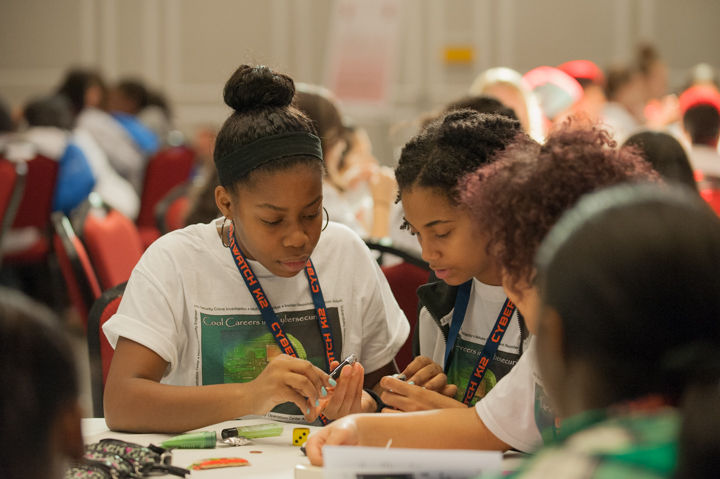
Jahna Crump and Ryann Haynes, 13, examine various household objects for one of the activities at the Cyber Security Careers for Girls event at Riggs Alumni Center on Nov. 12 2014.
At about 10 a.m. Tuesday, a group of middle school girls wearing matching white T-shirts formed a line leading into the Samuel Riggs IV Alumni Center.
The 350 girls from local schools were headed to the Cool Careers in Cybersecurity for Girls Workshop. The Maryland Cybersecurity Center and the Maryland Center for Women in Computing partnered with the National CyberWatch Center K-12 Division to host the annual event.
The event aims to foster discussion about cybersecurity careers and spark girls’ interest in the field.
“We put on multiple events because there is a shortage in the representation of women in this field,” said Jandelyn Plane, Maryland Center for Women in Computing director. “It is an issue we are addressing in many ways.”
Students came from schools across this state, including ones in Baltimore City and Howard, Montgomery and Prince George’s counties. Each student received a drawstring bag with notebooks, pens and hairbrushes.
During the three-hour program, participants rotated through four stations related to cybersecurity. Employees from companies such as Lockheed Martin, Google, Boeing, Northrop Grumman Corporation and the National Security Agency volunteered to man the stations and educate the student groups.
“What’s really impressive is how dedicated these volunteers are because they’re all professionals who basically take one day off to be there to teach these girls about cybersecurity,” said Michel Cukier, Maryland Cybersecurity Center’s education associate director.
This year’s program focused on vulnerabilities in medical devices. Coordinators showed a video of a man using his technology at home to slow down and speed up his own pacemaker.
At one station, students inspected computer parts and used diagrams to put the pieces together. Station volunteers explained the computer parts and their functions.
“Everyone uses computers, but when you open them up it’s cool to see how the parts work together,” said Cyndi Gula, operations vice president at Tenable Network Security and a volunteer at the station.
Volunteers at another station demonstrated how to pick a combination lock with a sharp piece of aluminum from a soda can. They asked students to brainstorm why physical security is important and come up with ways they could work to improve it.
In another area of the room, students used a legend with letters and numbers to solve encrypted codes. Participants also used a frequency chart, showing which letters appear the most often in the English language, to help crack the codes.
Volunteers at the fourth station led students in a discussion on how to make the work environment more secure and eliminate the threat of removable media, such as USB drives.
“The event is really based on the changing of activities,” Cukier said. “We move from one table to another, and part of the discussion is let’s go and work together on solving that problem, but also, the professionals will talk about what they’re doing as work and their experiences.”
At the conclusion of the event, four NSA employees spoke about their jobs, their college education and what sparked their interest in the field. One speaker shared her experience while in Afghanistan, where she protected computer systems from enemies. The speakers encouraged the young girls to build confidence in their work and not be afraid to try new things.
“I think it’s important for them to see how the STEM fields are related to everyday life and also to make connections with women in the field,” said Janelle Romano, lab for telecommunication sciences director at NSA.



